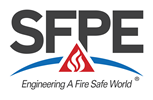FEMTC 2024
Convective Heat Transfer from Impinging Flames 
Jonathan Hodges, Randall McDermott (NIST) - Jensen Hughes
Abstract
Convective heat transfer in the Fire Dynamics Simulator (FDS) software is based on empirical relationships for natural and forced convection. The forced convection relationship typically dominates the convective heat transfer from a fire to a wall or ceiling in the near-field due to the magnitude of the buoyant velocity being generated by the plume. However, cases where the fire directly impinges on the surface lead to low forced convection heat transfer coefficients due to the local stagnation point. This results in a local minimum in the convective heat transfer coefficient where FDS transitions from a forced convection relationship to a natural convection relationship. However, this behavior is not seen in experiments where the peak heat transfer from an impinging fire is at the stagnation point. This paper presents the implementation of an existing impinging jet heat transfer relationship in FDS. Heat flux predictions from FDS are compared with experimental data on an impinging ceiling at multiple grid resolutions using the default and impinging jet models. The downstream impacts of these differences on the heating of a structural element are subsequently evaluated with a lumped capacitance thermal model.

